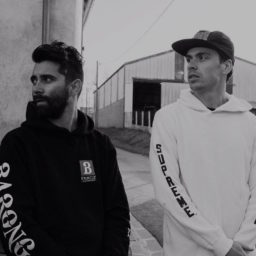Can Chew be to music what Twitch is to gaming? Find out what it takes to build the world’s largest video platform for DJs.

Wil Benton is one of the founders of Chew, a service that lets performers create a livestream of their DJ or studio sessions. They were launched in January 2015 and signed up tens of thousands of creators, broadcasting over fifty thousand performances.
Not only does Chew provide a platform where you can interact with DJs while they’re playing — it also functions as a massive archive of DJ sets, easily rivaling those of Boiler Room, and providing a more visual alternative to Mixcloud.
This is the first edition of a series of interviews with music startup founders and professionals. With the series, I want to shine a light on what goes on in music startups, how they work and what their challenges are. So, first up: Wil about building Chew.

—
How has the journey been since graduating from the Ignite startup accelerator?
It may sound cliched, but we really wouldn’t be here today without the support and guidance we had on the Ignite accelerator. The team were the first to believe in Ben Bowler and I as founders, investing in us as a team (our idea pre-programme wasn’t quite as strong as it is today!) and giving us the focus and headspace to start building what became Chew at the start of last year.
Our continuing success is testament to the Ignite team and all that they do — so can’t really say more than that!
—
Some people argue that investors are wary of investing in music startups due to uncertainties with rights and monetization. Have you encountered this?
In a word, no. Not yet anyway!
I think, had we not been demonstrating ‘interesting’ metrics and engagement on both sides of our creator & consumer marketplace, we would’ve found it harder to raise the two rounds of seed funding we’ve raised to date — but, on the whole, raising investment’s been a pleasure so far!
We’re gearing up to our first institutional round towards the end of this year; and conversations there have been promising too; again possibly thanks to the numbers we’ve got. That and the large amount of time we spend talking to our investors (both currently and looking to invest).

—
You ran a crowdfunding campaign letting users invest & get equity. What made you choose this?
We looked at crowdfunding as a way to fill part of the seed round we did at the start of this year. We’re building a community-based business, so it made sense to look at crowdfunding as a way of allowing our EU-based users to invest.
What better way to demonstrate we’re building something of value than our users actually investing in what we’re building?
We ended up having 122 individuals investing in the campaign; many Chew users but also supporters who saw value in what we’re doing. Seedrs, the platform we used, operate a nominee structure where their legal entity represents all 122 investors’ interest — but we have a great relationship with both parties and keep them in the loop with news on the business every fortnight.
Crowdfunding as a route to accessing capital isn’t the easiest thing to do — but as a way of generating interest in our community, product, and offering, it was unparalleled.
—
How did the idea of Chew come about?
Ben and I met the summer before we launched Chew — introduced by a mutual friend because we shared a love for music and tech. The predecessor to Chew was called EatBass (sticking with the culinary theme here!) and we spent a few months on that before I left my job at an advertising agency at the end of 2013.
Ben had spent a lot of time working with live streaming at his job with AEI and was being asked back to stream club nights and other events after having left. That’s originally where the idea for a live streaming platform for music came about. I started working full-time on Chew in that guise at the start of 2014, in a marketing and biz dev role. Meanwhile Ben covered the tech side by working evenings and weekends until joining me full time in August 2014.

It wasn’t until our time on the Ignite accelerator in October that we focused the idea being a platform and community for DJs and the electronic music community, though.
—
How did you assemble your team?
We raised an SEIS investment round in April 2015 after we’d finished Ignite, which gave us the capital to hire our CTO, Sam. We spent ages trying to hire for the full-stack role we wanted to fill; and Sam ended up finding our listing on the AngelList profile. He joined us the week after graduating with a Computer Science degree.
We’re still a team of three today; Sam as CTO, Ben as CSO/CVO and me as CEO. This year, we’ve been lucky enough to welcome a few ‘grownups’, who bring extensive industry experience to the team on a consultancy basis as we continue building out the business.
—
What are you happiest about regarding Chew? What pains you?
Our continuing success — and hearing about the value we’re adding to our users’ lives and careers on a daily basis!
Pain points are, thankfully, few and far between at the moment. Finances, given we’re working on a limited runway, and resource, being a team of three, have their downsides — but I wouldn’t have us operating in any other way!

—
What are you happiest about regarding Chew’s current feature set? And what bugs you?
We’ve achieved a huge amount in our short history — especially given we’ve only one (truly awesome) developer!
Our ability to plan, build and execute features to a reliable schedule — on top of bug fixes, community support etc — never ceases to amaze me.
In terms of personal bugs, it’s more of a resource issue than a problem with our features. We’ve got so much more to do, but our team is at capacity — so we need to expand to be able to improve what we have. So not necessarily a bug of mine; just conscious awareness that there’s only so much we can do as the lean team we are today!
—
You have over 25,000 DJs and producers on the service… How did they find out about Chew?
We had just under 30k users sign up in our first 18 months. We spent four or so months last year testing low level spend on Facebook ads (less than £5k) and, having just looked at the data, our numbers (in terms of engagement and platform usage) are actually better if we ignore the data from the duration of the Facebook spend.
Otherwise, our growth has been purely word of mouth. We turned Facebook ads off in August last year and haven’t looked back! We’re pretty active on the socials and in terms of community support, and we find that keeps our DJs and creators happy.
The happier [the DJs] are, the more content they produce on Chew and the larger the audiences they bring.
We’ve also just acquired our largest competitor, Mixify. The users we’re transitioning onto Chew is more than ten times our registered user number — so seeing how that impacts our numbers will be a fun journey!
—
How do you think DJs can benefit from live broadcasting?
Live streaming is an open, democratic process that allows anyone, anywhere in the world to share what they’re doing in realtime. It’s the realtime aspect that connects us as consumers, the ‘spontaneous togetherness’ we get from sharing this experience. Josh Elman, one of the VCs who invested in Meerkat, wrote a great blogpost about this.
For DJs, music producers, and personalities, it levels the playing field and enables anyone at any stage of their career to build an audience, drive that engagement that defines success as a musician and ultimately monetise their activities. That’s what we’re seeing with Chew — bedroom DJs building a global fanbase, established artists communicating with an engaged audience from their bedrooms or studios and record labels sharing new content from their artist rosters.
—
You mentioned spontaneous togetherness. How have you tried to foster that?
We are as hands off, from a platform point of view, as our creators want us to be.
Everything that happens on Chew is user-driven; our contribution to that is making sure the tech and platform makes things as easy as possible for our creators and consumers to engage with each other.
—
Do you think live streamed shows should be an essential part of any performing DJs digital strategy?
Yes — but potentially more than just shows. We see the best consumer engagement when our creators break away from the ‘let’s stream a show’ mentality.
It’s more about creating a consistent flow of content than sticking a webcam behind you in the club.
Live video is probably the most powerful thing, second to only live events, in a DJ, producer, or personality’s digital strategy for a number of reasons. Frequency and consistency are key, though. Without them, we don’t see as good an engagement from the audience side.

—
You mention frequency and consistency being key. Does that in any way contrast with ‘spontaneous togetherness’?
Great point — I hadn’t thought of it like that! Being consistently spontaneous kind of defeats the point doesn’t it 😉
I think, like I said earlier, allowing every creation and consumption decision to be user-driven helps drive this togetherness — but it’s the regularity of spontaneity that drives the behavioural change from a consumption side of things, which allows creators to maximise their audience’s engagement.
—
Are you going to be launching Twitch-style monetization options like donations and subscriptions?
We’re working on a number of new features — watch this space!
—
Do you have any words of advice for people with a genius music startup idea and other founders?
I’ll let Betaworks/ Startup Vitamins answer this for me.
One of the things we learned on Ignite:
You can never have a product in users’ hands too quickly.
Build, launch and iterate as fast as you can.
—
Follow Wil & Chew on their journey:












